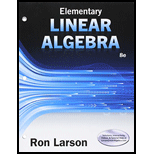
Guided Proof Prove that if
Getting Started: To prove that
| (i) | Write
|
| (ii) | Form the inner product of
|
| (iii) | Use the properties of inner products to rewrite the inner product
|
| (iv) | Use the fact that
|
Want to see the full answer?
Check out a sample textbook solution
Chapter 5 Solutions
Bundle: Elementary Linear Algebra, Loose-leaf Version, 8th + MindTap Math, 1 term (6 months) Printed Access Card
- 2. Select all of the polynomials with the degree of 7. A. h(x) = (4x + 2)³(x − 7)(3x + 1)4 B h(x) = (x + 7)³(2x + 1)^(6x − 5)² ☐ Ch(x)=(3x² + 9)(x + 4)(8x + 2)ª h(x) = (x + 6)²(9x + 2) (x − 3) h(x)=(-x-7)² (x + 8)²(7x + 4)³ Scroll down to see more 2 of 10arrow_forward1. If all of the zeros for a polynomial are included in the graph, which polynomial could the graph represent? 100 -6 -2 0 2 100 200arrow_forward3. Select the polynomial that matches the description given: Zero at 4 with multiplicity 3 Zero at −1 with multiplicity 2 Zero at -10 with multiplicity 1 Zero at 5 with multiplicity 5 ○ A. P(x) = (x − 4)³(x + 1)²(x + 10)(x — 5)³ B - P(x) = (x + 4)³(x − 1)²(x − 10)(x + 5)³ ○ ° P(x) = (1 − 3)'(x + 2)(x + 1)"'" (x — 5)³ 51 P(r) = (x-4)³(x − 1)(x + 10)(x − 5 3 of 10arrow_forward
- Match the equation, graph, and description of transformation. Horizontal translation 1 unit right; vertical translation 1 unit up; vertical shrink of 1/2; reflection across the x axis Horizontal translation 1 unit left; vertical translation 1 unit down; vertical stretch of 2 Horizontal translation 2 units right; reflection across the x-axis Vertical translation 1 unit up; vertical stretch of 2; reflection across the x-axis Reflection across the x - axis; vertical translation 2 units down Horizontal translation 2 units left Horizontal translation 2 units right Vertical translation 1 unit down; vertical shrink of 1/2; reflection across the x-axis Vertical translation 2 units down Horizontal translation 1 unit left; vertical translation 2 units up; vertical stretch of 2; reflection across the x - axis f(x) = - =-½ ½ (x − 1)²+1 f(x) = x²-2 f(x) = -2(x+1)²+2 f(x)=2(x+1)²-1 f(x)=-(x-2)² f(x)=(x-2)² f(x) = f(x) = -2x²+1 f(x) = -x²-2 f(x) = (x+2)²arrow_forwardWhat is the vertex, increasing interval, decreasing interval, domain, range, root/solution/zero, and the end behavior?arrow_forwardThe augmented matrix of a linear system has been reduced by row operations to the form shown. Continue the appropriate row operations and describe the solution set of the original system. 1 -1 0 1 -2 00-4 0-6 0 0 1 - 3 3 0 001 4arrow_forward
- Solve the system. X1 - 3x3 = 10 4x1 + 2x2 + 3x3 = 22 ×2 + 4x3 = -2arrow_forwardUse the quadratic formula to find the zeros of the quadratic equation. Y=3x^2+48x+180arrow_forwardM = log The formula determines the magnitude of an earthquake, where / is the intensity of the earthquake and S is the intensity of a "standard earthquake." How many times stronger is an earthquake with a magnitude of 8 than an earthquake with a magnitude of 6? Show your work.arrow_forward
- Now consider equations of the form ×-a=v = √bx + c, where a, b, and c are all positive integers and b>1. (f) Create an equation of this form that has 7 as a solution and an extraneous solution. Give the extraneous solution. (g) What must be true about the value of bx + c to ensure that there is a real number solution to the equation? Explain.arrow_forwardThe equation ×+ 2 = √3x+10 is of the form ×+ a = √bx + c, where a, b, and c are all positive integers and b > 1. Using this equation as a model, create your own equation that has extraneous solutions. (d) Using trial and error with numbers for a, b, and c, create an equation of the form x + a = √bx + c, where a, b, and c are all positive integers and b>1 such that 7 is a solution and there is an extraneous solution. (Hint: Substitute 7 for x, and choose a value for a. Then square both sides so you can choose a, b, and c that will make the equation true.) (e) Solve the equation you created in Part 2a.arrow_forwardA basketball player made 12 out of 15 free throws she attempted. She wants to know how many consecutive free throws she would have to make to raise the percent of successful free throws to 85%. (a) Write an equation to represent this situation. (b) Solve the equation. How many consecutive free throws would she have to make to raise her percent to 85%?arrow_forward
- Algebra & Trigonometry with Analytic GeometryAlgebraISBN:9781133382119Author:SwokowskiPublisher:Cengage
 Elementary Linear Algebra (MindTap Course List)AlgebraISBN:9781305658004Author:Ron LarsonPublisher:Cengage Learning
Elementary Linear Algebra (MindTap Course List)AlgebraISBN:9781305658004Author:Ron LarsonPublisher:Cengage Learning Trigonometry (MindTap Course List)TrigonometryISBN:9781337278461Author:Ron LarsonPublisher:Cengage Learning
Trigonometry (MindTap Course List)TrigonometryISBN:9781337278461Author:Ron LarsonPublisher:Cengage Learning  Algebra and Trigonometry (MindTap Course List)AlgebraISBN:9781305071742Author:James Stewart, Lothar Redlin, Saleem WatsonPublisher:Cengage Learning
Algebra and Trigonometry (MindTap Course List)AlgebraISBN:9781305071742Author:James Stewart, Lothar Redlin, Saleem WatsonPublisher:Cengage Learning Linear Algebra: A Modern IntroductionAlgebraISBN:9781285463247Author:David PoolePublisher:Cengage Learning
Linear Algebra: A Modern IntroductionAlgebraISBN:9781285463247Author:David PoolePublisher:Cengage Learning




